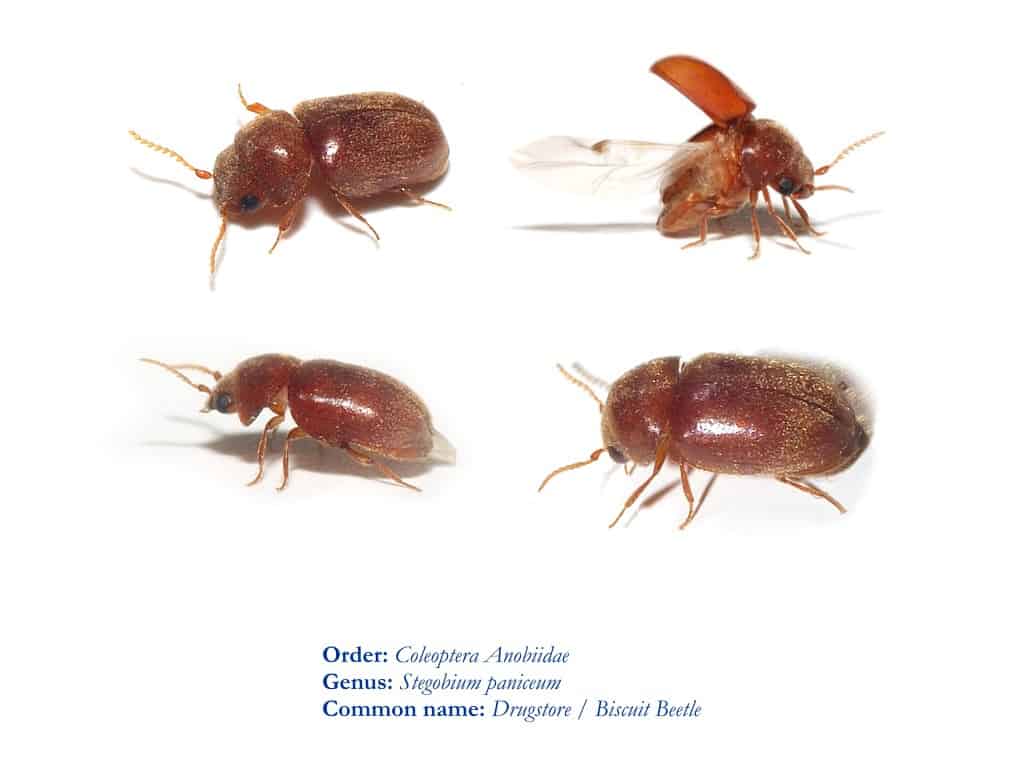
If you enjoy reading this article, why not check out our articles on Are Ants Active at Night? and I Saw One Cockroach, Should I Be Worried?
What Are These Small, Tiny Brown Bugs?
Tiny Brown Bugs: Whenever people think about household pests, they think about ants, cockroaches, and rats. But there is another threat possibly lurking out there, trying to make its way into your house!
Are They Dangerous? If you have found yourself in the unfortunate position of having your own home infested with tiny brown bugs, is it time to panic? Well, probably not.
More often than not, these common household pests are not dangerous to humans — they spread no diseases. Even though they present no harm, most people will find them disgusting, and rightly so.
Tiny brown bugs can be found anywhere: your kitchen, your bathroom, somewhere in hollow wood (wood the bugs themselves might hollow) and even on your beloved pet.
They can reproduce: They might be tiny, but many bugs can quickly become a huge problem due to their reproduction habits. Whenever you find one, you need to understand you might be facing an infestation and you should act accordingly.
Dealing with brown bugs: Getting rid of tiny brown bugs is no easy feat, but it’s completely doable.
Even though you will be capable of eliminating the bug pest troubling you, you should always count on prevention tactics to avoid further trouble.
Before you think about how you are going to eliminate them, you should know who you are dealing with. So, we’ll start by identifying the most common tiny brown bugs and then discuss the best ways to get rid of them. Ready? Let’s start!
Cockroaches are one of the scariest household pests there are! If you’re curious why they might be in your home, check out our article about it: Why Do I Have Cockroaches in My Home?
What Is a Tiny Brown Bug?
A “tiny brown bug” is an umbrella term for a couple of insects that might be living between your walls. There are three common types of tiny brown bugs: the silverfish, the beetle, and the tick. Each one has their own habits, food preference, and behavior.
Silverfish
Also known as the librarian’s enemy, the silverfish thrives in dark, humid places. These bugs feed off paper and cardboard: they often target books, and they can destroy an entire book collection if given enough time.
Even though they like to eat paper, silverish love moisture and damp places, making a bathroom the perfect place for them to live. They are commonly found behind faulty sinks or toilets. Even though they present no damage to humans, they can harm plenty of objects: books, as mentioned, and clothes are their main targets.
The good news is, they definitely won’t harm you. Silverfish don’t bite and don’t carry any diseases. But if you care about your books or wallpaper, thinking about a silverfish infestation might be enough to send shivers down your spine.
How to Identify a Silverfish
Silverfish are quite small, although not as small as some other bugs: adults are typically around half an inch long. These bugs have an elongated body (somewhat like a fish) and their color is grayish-brown, almost like silver if the light hits right. You can see where the name comes from.
If you look really closely, you’ll notice 2 antennas coming from the head of the silverfish. On the other end of the body, there are 3 tail-like extensions. This is why silverfish are also sometimes called bristletails.
Fun fact: Silverfish are some of the earliest insects. Scientists believe they walked the earth together with dinosaurs!
For more about silverfish, check out this article:
Are Silverfish Dangerous? 7 Things to Know
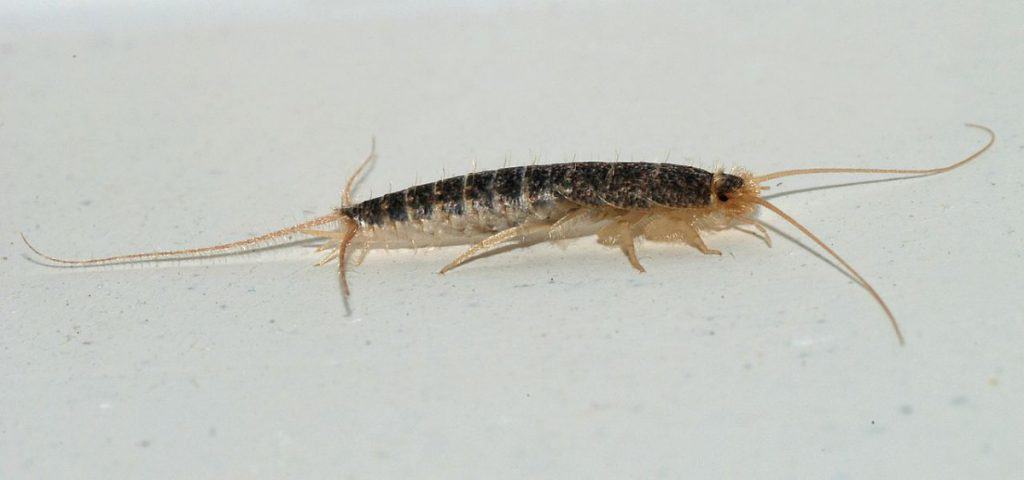
Beetles
The order of beetles (order Coleoptera, scientifically) is the largest order of insects. It includes around 400,000 (yes, you’ve read that right) different species, and they are all beetles. The largest beetles can be up to 20 cm long and the smallest insect in the world is also a beetle (Scydosella musawasensis – 0.3mm long).
But, you probably won’t find any of those in your home. However, there are a few common species that are typically found in houses, and they are often tiny and brown.
The beetle is commonly found in kitchens or anywhere you might be storing food they can reach. The beetle is well known for feeding off flour but they won’t stop there; they can easily live off any animal or vegetable product, spices and certain kinds of drugs.
House beetles prefer dark and warm places. The warmer their habitat is, the better: if temperatures drop below 15C, they will reproduce once per generation, but if temperatures go above 23C they will reproduce five times more than usual. Due to their reproductive nature (they lay eggs into food), anytime you see a beetle near your kitchen, you need to dispose of any opened food package.
Below are the most common tiny brown beetles that might be walking around your home.
But it’s worth saying that it’s not really necessary to identify the exact type of beetle you are dealing with. Most of them behave in a similar manner.
Drugstore Beetles
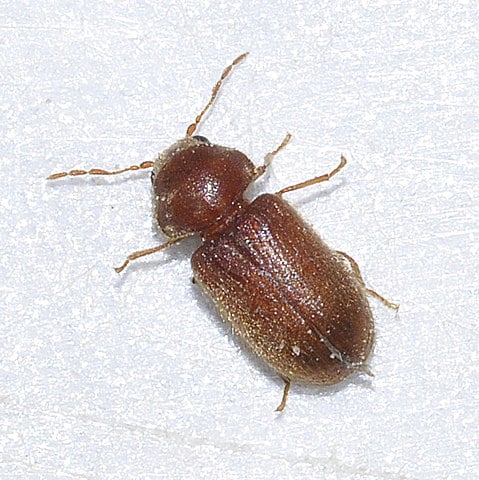
Drugstore beetles are also called biscuit beetles. As you might guess, they are called like this because they like to hang around biscuits and other foodstuffs. They are 2-3 mm long (around 0.1”) – that means, very tiny. They are flat and have an oval body shape.
While drugstore beetles can fly, they don’t do so frequently and you’ll most likely see them crawling around.
Weevils
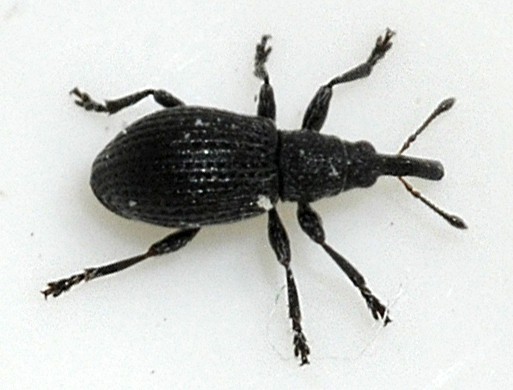
There are many different kinds of weevils, but the ones you are most likely to see in your home are flour weevils, rice weevils, or a similar species. They are usually 3-5 mm long – that is, slightly larger than drugstore beetles.
If you look really closely, you’ll recognize the weevil by the long snout stemming from its head.
Flour Beetles
Flour beetles are also brown with an oval body. Also around 3 mm long. As you can see, they are slightly more elongated than drugstore beetles.
Spider Beetles
Spider beetle is another type of beetle that might invade kitchens or pantries. It’s tiny, brown, and it looks somewhat like a spider, only with a hard shell. Their round body shape is what makes them different from other tiny brown beetles.
Ticks
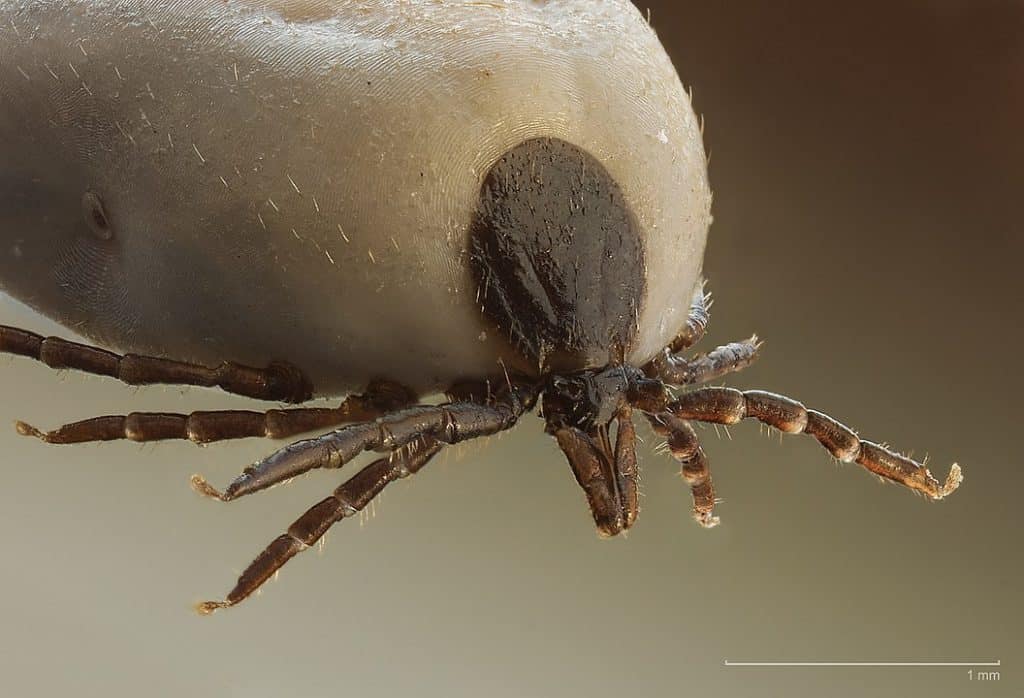
This is a less commonly found tiny brown bug, but it’s also the most dangerous one.
Ticks are parasitic and feed off the blood (usually a pet’s blood, but some ticks feed off humans too). They are one of the few tiny brown bugs that can transmit diseases. Lyme disease is the most well-known disease transmitted by ticks and the one we most often worry about, but there is actually a range of other diseases that ticks can transmit.
The good news about ticks is they cannot travel great distances without help: if you found one it means the culprit is around, a wild animal or your pets. It’s hard to face a tick infestation if you don’t own any pets, but if you do, this is the worst type of tiny brown bug you may fight.
How to Identify a Tick?
Ticks are common world-wide and there are hundreds of different kinds of ticks. Some are more dangerous than others, but they all look fairly similar. They are usually very small. Depending on the age, a tick can be as small as a grain of sand or a poppy seed, and adult ticks can be about the size of a sesame seed.
If you look really close, ticks appear flat and round. They usually have 8 legs, but they can also have 6 (in the larval stage). Once they bit a victim and start feeding on blood, ticks can grow very large.
There Are Tiny Brown Bugs All Over My Bathroom: Are They Dangerous?
As you probably know by now, if you found a tiny brown bug lurking around your bathroom, you have probably found a silverfish.
They love damp, humid places. Especially if they are dark enough.
Luckily for humans, the silverfish isn’t dangerous. But they can bring potential damage to your material goods: they’ll go after paper, glue, hair, photos, cotton, silk, coffee and sugar. They eat many things, and they have many predators as well: house centipedes, spiders, among many other predatory insects choose to hunt down silverfish for a nutritious meal.
If you found one silverfish, there’s probably many more living nearby. The silverfish has a long lifespan, which can extend to eight years.
Silverfish practice intricate reproduction rituals. By the time this is over up to 60 eggs will make their way into our world. Even though they live for long and reproduce quickly, they only lay up to 100 eggs during their lifetime.
Bathrooms can be a breeding ground for bugs! You especially may find ants in your bathroom. If you do, you can refer to our article Tiny Ants in the Bathroom?
I Found Tiny Brown Bugs In My Kitchen Pantry: Why Are They There?
If you find tiny brown bugs moving around your kitchen and feeding off what you poorly stored in your pantry or cupboards, you are probably dealing with a type of beetle. Most likely they will be biscuit beetles, also known as drugstore beetles.

Beetles are all about food; they will try to make their way into bread, cookies, and any other stored food you may have. Preferably, they will look for mostly-unused stored food like spices or flour. They favor these kinds of things due to their reproductive nature: they will lay their eggs near the source of food and the eventually-hatched larvae will make its way there to start eating. A beetle might do a lifetime’s worth of eating during its larval stage, as adult beetles are commonly found away from the stored food and further into warmer territories, like a fireplace. Beetles love heat, and thrive in warmer places.
The main problem with beetles is how long it takes to notice them. They often reproduce near rarely used stored food. It’s not until the adults wander off that a homeowner might notice them. By that time, there are plenty of larvae and adult beetles living inside the house.
Beetles are all about food; they will try to make their way into bread, cookies, and any other stored food you may have.
Preferably, they will look for mostly-unused stored food like spices or flour. They favor these kinds of things due to their reproductive nature: beetles will lay their eggs near the source of food and the eventually-hatched larvae will make their way there to start eating.
A beetle might do a lifetime’s worth of eating during its larval stage, as adult beetles are commonly found away from the stored food and further into warmer territories, like a fireplace. Beetles love heat, and thrive in warmer places.
The main problem with beetles is how long it takes to notice them. They often reproduce near rarely used stored food. It’s not until the adults wander off that a homeowner might notice them. By that time, there are plenty of larvae and adult beetles living inside the house.
The Tiny Brown Bugs Are Living on My Pets: What Should I Do?
The tiny browns are not living on your pets, but rather feeding off your pets. Ticks are parasitic tiny brown bugs that can be found on animals and sometimes on humans. They feed off blood and can transmit quite a few diseases, some of them deadly for both animals and humans alike. If you found a tick in your house, you are probably not dealing with an infestation unless you live with a large number of animals inside your home. Whether you are surrounded by animals or not, ticks are dangerous enough to take them seriously no matter what.

Ticks can live up to three years and will reproduce during the summer. Even though they prefer warmer temperatures, they are found all over the world. If you find a tick in your house, make sure to take care of your animals. If you are certain they are suffering from a tick-related infestation, it’s best to take them to a professional, as tick removal can be a complicated issue to go through.
Another type of tiny brown bug that might come from your pets is a flea.
The Tiny Brown Bugs Are Flying Around the House: Are These the Same or Different?
If you are facing a problem with tiny brown bugs that can fly, you are probably dealing with none of the already listed bugs you are now familiar with.
Neither drugstore beetles or silverfish fly, nor can they go past certain heights by themselves. Ticks, on the other hand, can reach certain heights, but they do so by jumping around leaves, sticks, branches and other things found in nature — their objective is to eventually land on a host.
If the tiny brown bugs you saw had wings, they probably were fruit flies or fungus gnats. They both look alike and behave alike. They prefer warmer, moist habitats. They feed off decaying matter – like rotten fruit – and produce. You will usually find these kinds of flying brown bugs if you have plants or a big garden. The best way to solve a flying brown bug problem would be to dry out the soil, remove (or repot) your plants, use hydrogen peroxide to kill the larvae and use traps to catch adult fruit flies and fungus gnats.
Flying tiny brown bugs are different from commonly found tiny brown bugs. They tend to be rarer and appear in specific scenarios regarding gardening and botanical endeavors.
A lot of our readers also ask about tiny black bugs found in the homes and beds, we wrote an entire article covering it. Make sure to check it out after reading this one here.
How Do I Get Rid of Tiny Bugs in My House?
As a general rule, my advice would be to purchase a UV based home trap. The more modern designs such as the KATCHY Indoor insect trap look genuinely cool when placed around your home and they are effective for a variety of pests.
If however you want to specifically target a particular type of insect then here’s my advice broken down by species:
Dealing with Beetles
If you have found a beetle, get ready to make a close inspection of anything food-related around your house. Check your pantries and cupboards for any stored food or open food packages. Check places where food is, even though it might be unusual: fireplaces usually have breadcrumbs birds tend to drop into.
Anywhere dark and safe can become the next place where a beetle will leave their eggs to hatch. Clean everything up and throw away compromised food. Once you have removed their food source, the beetles will slowly disappear. Make sure to keep a clean kitchen afterward to avoid further issues.
Dealing With Silverfish
Dealing with a silverfish infestation is trickier, but it can be done. Place sticky traps anywhere near the infestation to deal with any silverfish that might wander around. If you don’t have children or pets, you can use poison to quickly eliminate them. If you do have either of them, try to look for safer alternatives.
While these bugs walk to their death via traps or poison, make sure to clean up any damp or overly humid corners inside your house. Removing the source of the problem will prevent future infestations and make it harder for current silverfish to live.
Listen, if you want to take care of silverfish or beetles effectively and quickly. Then I’d pick up a General Pest Control Starter Kit. It’ll work just fine for either and get the job done.
Dealing with Ticks
And finally, if you are trying to deal with ticks, it’s best to take it to a professional vet to deal with the issue. Tick removal can prove tricky and sometimes dangerous.
It’s not worth it to risk it. And even if you manage to remove every single tick of your pet, you will have to buy something from your vet that’ll work as a preventive measure until you sort out where the ticks came from.
If however you just want to treat your home and garden for ticks then pet safety is much less of an issue. I’d recommend getting an DynaTrap DT1775 Insect Trap. Which should tackle the problem pretty quickly.
If you want to learn more about various insects, then checkout our site categories, we have a bunch of articles there that are totally worth reading:
P.S.
That’s it for this article. I hope you enjoyed reading it and if you think it might be useful for someone else then please share it on social media, email or your own website! It really encourages us to write more content and grow the site!
All the best
Steve
If you enjoyed reading this article, why not check out our articles on What is the Rarest Bug in the World? and The 5 Creepiest Bugs
Recent Posts
Tiny Black Bugs in Bathroom NO WINGS: What They Are and What to Do!
Finding tiny black bugs in your bathroom can be uncomfortable, to say the least. Especially if they are persistent, or they appear in very large numbers, which they often like to do. When it...
Tiny Black Bugs in Plant Soil - What Are They & What To Do About It
A short horror story: You get a new houseplant. You do your best to take care of it. You’ve ensured that it has the right soil, the right amount of sun, it gets enough water. And then one day, you...

